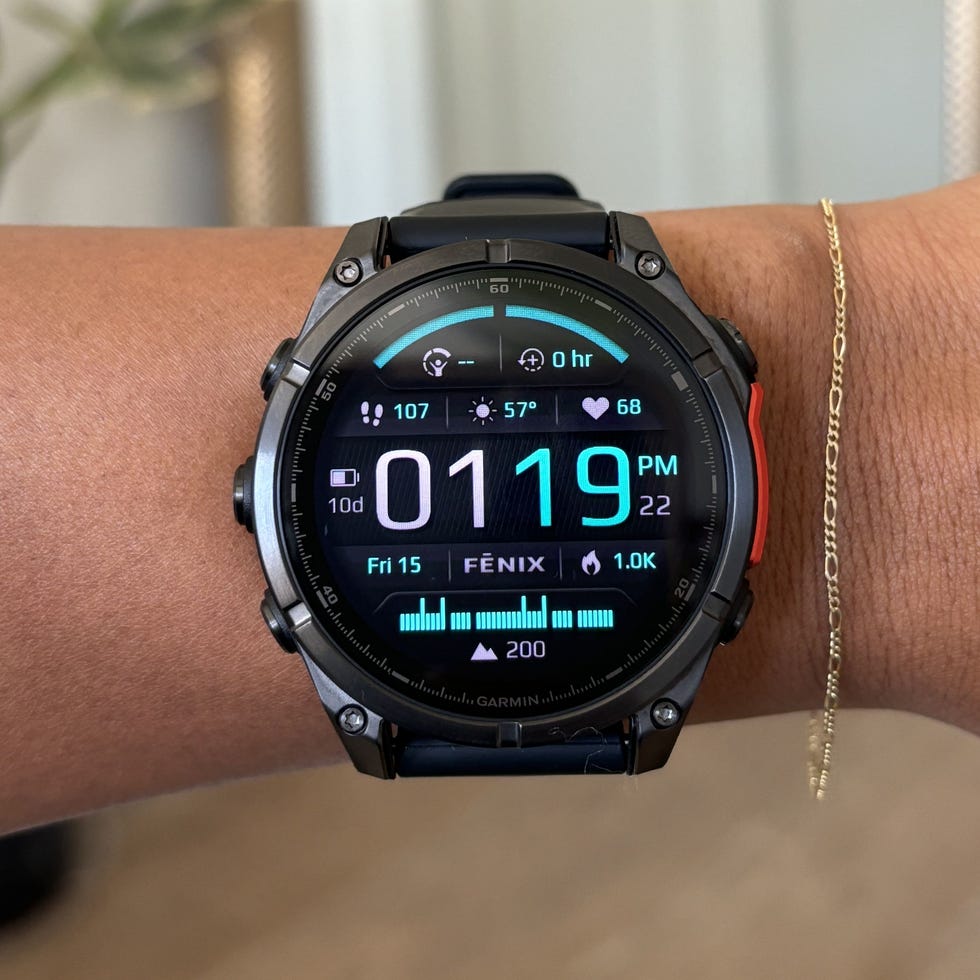When it comes to fitness trackers, the winner for you will always be the one that meets your needs. If you’re like me, those needs are tracking sleep and workouts, and keeping me motivated to move. I was happy to discover that a Garmin watch provides more than just data tracking–it also gives me coaching and recovery, so I can perform my best whether that’s at the gym or in a meeting.
My favorite feature—and the main reason I would recommend a Garmin watch—is Garmin’s Body Battery Energy Monitor which provides a real-time energy score of 1 to 100 that’s dependent on your heart rate variability, stress levels, physical activity, and sleep quality. Each of those variables is tracked down to the minute so that you can see what is draining your energy and what is recharging it. I have not experienced a feature quite like this on other wearables I’ve tried. (To get the most out of a Garmin watch, I suggest wearing it day and night since the sleep data is an integral part of Garmin’s Body Battery Energy Monitor.)
With Many Garmin Watch Models Available, You Should First Consider:
- What are your main activities or fitness goals?
- What health features are important to you?
- Where will you wear the watch?
Once you’ve answered those questions, I’ve got you covered with a review of eight different Garmin Watch models to help determine which one meets your needs best.
My Testing Focused On Key Factors Such As:
- How accurately the watches track fitness metrics
- Comfort during workouts
- Design and fit for daily wear
- Durability against sweat and wear and tear
- Battery life
- Ease of use
- Readability of the screen in different lighting conditions
As I tested each watch, I also compared features across different Garmin models like user interface intuitiveness, durability, and functionality for both casual fitness enthusiasts and more serious athletes.
By wearing each watch across a variety of activities and day-to-day situations, I was able to thoroughly evaluate which Garmin watches truly stand out in terms of performance, style, and overall value.
What To Consider
Activity Tracking
A Garmin watch can track a variety of activities, including walking, running, cycling, cardio, strength, breathwork, and more. One thing I appreciate is that it makes training easier since it tracks all of your data and on the Garmin Connect App you can search for workouts to download or create your own workouts to add to a Garmin watch that is compatible.
Generally, all Garmin watches track steps, calories, and active minutes. For runners, it offers metrics on pace, distance, and cadence, and certain models will track stride length and ground contact. Cycling provides GPS tracking, ascent, and speed. Swimmers can use the watch to track laps, strokes, and distance. When you’re outdoors, some of the Garmin watch models utilize GPS navigation and elevation tracking. When strength training, all of the Garmin watches I tested can track sets, reps, and weight.
Rep tracking during workouts is done automatically (or you can change it to manual in the settings), and then you simply press the main button to indicate you’ve finished your set. The Garmin watch then tracks rest between sets until the button is pressed to indicate a new set. After each set, the watch allows you to enter the weight you used. I found the rep-set tracking features to be a really impressive and robust way to keep track of your progress in the gym! Within the watch, you can edit the data afterward to include the exercise name and make any necessary adjustments to the workout.
If you’re someone who loves to keep track of your progress and document how you felt during a workout, the Garmin Connect App allows you to add comments to completed activities to refer back to how you felt, and anything you may want to reference later.
Health Data
There are health stats on the Garmin Connect App that leverage the data from your watch so that you can understand your overall well-being better. These stats include:
- Training status and readiness gauge your fitness and recovery levels to help you determine whether you’re ready for a challenging workout or need rest.
- HRV (heart rate variability) status and VO2 max provide insight into cardiovascular health and endurance.
- Race predictor allows you to see a prediction of your race times for various distances (this feature uses a variety of metrics to provide the estimates).
- FTP (Functional Threshold Power) gives you an idea of your performance ability by providing a snapshot of your highest power level that can be sustained for one hour.
- The power curve gives you an understanding of the maximum power you used for a given time interval.
- Lactate threshold measures the specific level of effort or pace when fatigue accelerates.
- Critical swim speed is Garmin’s theoretical measure of the fastest pace that a swimmer can maintain continuously without exhaustion.
- Endurance score reflects changes in your endurance, this number uses every activity that is measured by your heart rate to help determine it. Higher scores reflect more capacity for longer activity.
- Hill score is a 1-100 rating that indicates how skilled your uphill running is. Garmin watches with this feature analyze all of your running, walking, or hiking activity with uphill segments graded more than 2% percent.
- HRV stress (for this you’ll need a Garmin chest heart rate monitor) measures how well you manage stress on challenging terrain.
Beyond performance stats, Garmin watches also provide comprehensive health stats for daily well-being. These include sleep tracking, which gives insights into sleep quality and recovery, and the Garmin body battery (as mentioned above).
Key health markers like respiration, heart rate, blood pressure, and stress tracking allow for ongoing health monitoring, while Pulse Ox measures blood oxygen levels and adapts to altitude with Pulse Ox acclimation features. For those tracking nutrition and hydration, Garmin watches offer calorie tracking (by pairing the watch with MyFitnessPal), hydration tracking, and menstrual cycle tracking. Additionally, the fitness age and health snapshot provides an interesting look into your health.
Size And Fit:
- There’s a range of models to suit different preferences. From smallest to biggest:
- A minimalist option is the Vívosmart 5, which has a narrow band that makes it lightweight and comfortable, especially if you’re looking for a watch without a bulky watch face.
- The Lily 2 Active is Garmin’s most stylish model that has a delicate design that looks more like jewelry than a fitness watch.
- The Vivoactive 5 and Venu 3s are similar in that they maintain a slim profile but with a slightly larger display that balances comfort and visibility, making them great everyday options.
- The Forerunner 265s offers a compact and comfortable fit, ideal for runners who want something lightweight.
- On the other end of the spectrum, the Instinct 2s offers a rugged look, tailored to outdoor enthusiasts who need durability.
- If you’re after something substantial, the Fēnix 8 and Enduro 3 models are the largest, built for extreme sports and adventure with big displays, and extended battery life to match. These watches are bulkier, but they provide the screen size needed for viewing maps.
For me personally the Fēnix 8 and Enduro 3 models are too big for my wrist. Overall, Garmin’s variety in sizes ensures there’s an option that meets everyone’s preferences.
Battery Life
Garmin watches are known for their impressive battery life. I was always so surprised to look down on my wrist and see 15 days or more on some of the models! Here’s a breakdown based on the approximate battery life in smartwatch mode:
- Forerunner 265s: 15 days
- Vivoactive 5: 11 days
- Venu 3s: 10 days
- Lily 2 Active: 5 days
- Vívosmart 5: 7 days
- Instinct 2s: 21 days
- Garmin Fēnix 8: 16 days
- Garmin Enduro 3: 36 days
How I Selected
I tested eight of the most talked about models (in fitness circles and on social media and online retailers) for at least three days each, 24 hours a day. During this time, I ran, cycled, strength trained, and wore the watches during everyday activities to assess their performance in real-world conditions. The watches I tested include the Forerunner 265s, Vivoactive 5, Venu 3s, Lily 2 Classic, Vivosmart 5, Instinct 2s, Garmin Fenix 8, and Garmin Enduro 3.
” data-next-head/>

Nellie Barnett, CPT, is an online fitness and lifestyle coach and the founder of NellBells Fitness, where she helps women unlock their full potential through activities focused on the body, mind, and soul. She studied personal training and nutrition and has her bachelor’s in advertising and marketing from the Fashion Institute of Technology.
Jacqueline Andriakos is the Executive Health & Fitness Director at Women’s Health, where she oversees all health and fitness content across WomensHealthMag.com and the print magazine. She has more than a decade of experience writing and editing in the wellness space and has contributed to national publications including Time, Self.com, Health, Real Simple, and People, among others. Jacqueline is also certified in personal training by the National Academy of Sports Medicine (NASM).
Watch Next

Advertisement – Continue Reading Below
Advertisement – Continue Reading Below
Advertisement – Continue Reading Below









